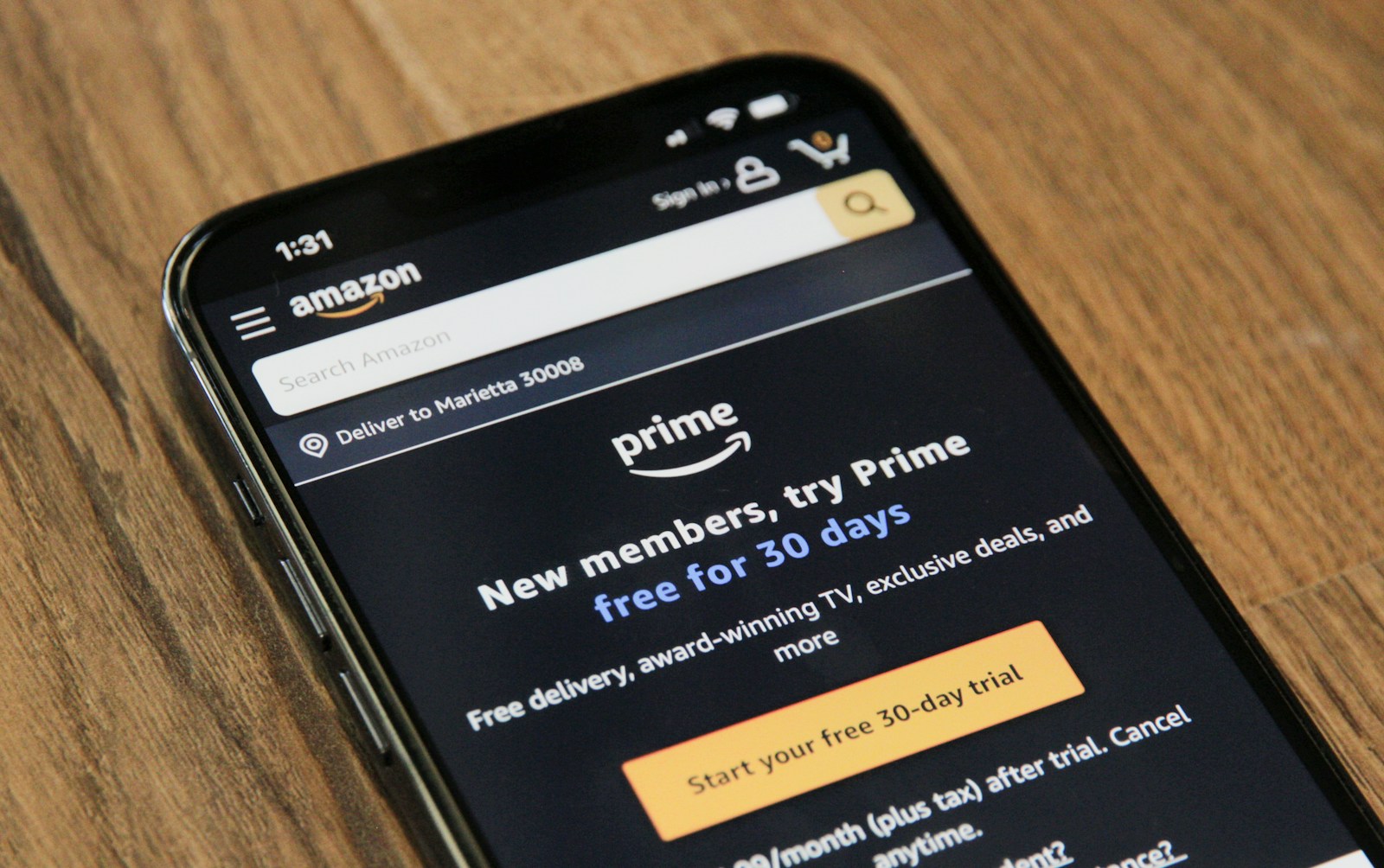Have you ever opened an email that claimed to be from Amazon and instantly felt something was off? You’re not alone—and you’re not imagining it. Scammers are constantly refining their tactics, creating emails that look nearly identical to the real thing. With millions of people shopping on Amazon every day, these scams are highly effective because they tap into a brand we trust.
In 2025, fake Amazon emails have become so convincing that even tech‑savvy shoppers have been tricked. They often use Amazon’s logos, fonts, and color schemes, and they’ll reference real services like Prime memberships, orders, or payment methods. The goal? To create urgency and push you into clicking a malicious link or giving away personal information.
🕵️♂️ What’s Happening Right Now
Amazon recently sent out a global alert to its 200 million Prime members, warning about a surge in phishing attempts. Here’s how these scams are evolving in 2025:
- Subscription Scams: Many emails claim your Prime renewal fee is increasing or that your payment method failed. They’ll include a big button like “Cancel Subscription” or “Update Payment” that actually takes you to a fake login page designed to steal your Amazon credentials and credit card info.
- Order Confirmation Traps: Others pretend you made a high‑value purchase. The email says, “If you didn’t order this, click here,” baiting you into a fraudulent support portal.
- Time‑Sensitive Threats: Phrases like “Account locked,” “Suspicious login,” or “Payment declined” are designed to scare you into immediate action.
- Fake Domains: Security researchers have tracked more than 1,200 new look‑alike domains launched around Prime Day and holiday seasons. Many end in extensions like “.co,” “.org,” or slightly misspell “amazon.”
🔍 How to Spot a Fake Amazon Email
Even the most realistic emails leave clues if you know what to look for:
- Check the Sender’s Address: Real messages come from an official
@amazon.comdomain. Watch for sneaky variations like@amazom-support.comor@amazon-secure.net. - Look at the Greeting: Amazon knows your name. Be wary of emails starting with “Dear Customer” or “Dear User.”
- Scrutinize the Tone: A threatening, urgent tone—like “Act within 24 hours or lose access”—is a hallmark of phishing.
- Scan for Errors: Typos, odd spacing, and clunky grammar are red flags that a legitimate corporate email wouldn’t have.
- Hover Over Links: On a computer, place your cursor over a link without clicking. A real Amazon link will start with
https://www.amazon.com—anything else is suspicious. - Use Your Message Center: Sign in to Amazon directly and check your Message Center. If the email isn’t there, it isn’t real.
- Look for Verified Logos: Many email clients now show brand‑verified icons (like the Amazon smile logo) next to genuine emails.
✅ What You Should Do if You Get One
If something feels off, don’t take chances:
- Don’t click links or download attachments. Go straight to Amazon’s website or app and log in directly to check your account.
- Enable two‑step verification or Passkeys. This adds an extra layer of protection, even if someone gets your password.
- Forward suspicious emails to Amazon: Send them to stop-spoofing@amazon.com so their security team can investigate.
- Monitor your financial accounts: If you clicked something by mistake, keep a close eye on your bank statements and change your Amazon password immediately.
- Use security tools: A good password manager, up‑to‑date antivirus software, and virtual cards for shopping can drastically reduce your risk.
🧠 Stay Ahead of the Scammers
The reality is, fake Amazon emails aren’t going away—they’re evolving. By learning the latest tricks scammers use and staying vigilant, you can shop with confidence:
- Always pause before you click.
- Verify in your Amazon Message Center.
- Double‑check sender details and URLs.
- When in doubt, report and delete.
Staying informed is your best defense, and knowing what to look for can save you from a costly mistake the next time a suspicious “Amazon” email lands in your inbox.
Example Fake Emails
Here are several examples of fake Amazon‑style emails that highlight different types of phishing attempts so you can quickly see what red flags to look for.
📧 Example 1 – Fake Prime Renewal Notice
From: Amazon Support <no-reply@amaz0n-billing.com>
Subject: Urgent: Your Amazon Prime Renewal Has Failed
Dear Customer,
We were unable to process your recent payment for your Amazon Prime membership.
Your account will be suspended within 24 hours if you do not update your billing information.
To continue enjoying Prime benefits, please confirm your payment details here:
[Update Now]
Thank you for shopping with Amazon.
Amazon Billing Team
⚠️ Red flags: sender domain is wrong (amaz0n-billing.com), generic greeting, urgent threat, suspicious link.
📧 Example 2 – Fake Order Confirmation
From: Amazon Order Department <orders@amazon-support-team.net>
Subject: Order Confirmation #4593201 – Apple iPhone 15 Pro Max
Hello,
Thank you for your order! Your Apple iPhone 15 Pro Max will be shipped to:
John Street
Random City, USA
If you did NOT make this purchase, please click the link below to cancel immediately:
[Cancel Order]
Thank you for choosing Amazon.
⚠️ Red flags: unexpected order, non‑Amazon domain, urgent cancellation link.
📧 Example 3 – Fake Account Suspension Warning
From: Amazon Account Security <alert@amazonverify.co>
Subject: Immediate Action Required – Account Suspended
Dear Amazon User,
We detected unusual login attempts on your account. For your security, we have temporarily locked your account.
Please verify your identity to regain access:
[Verify Now]
Failure to verify within 12 hours will result in permanent account closure.
Amazon Security Team
⚠️ Red flags: threatening time limit, generic greeting, fake domain (amazonverify.co).
📧 Example 4 – Fake Gift Card Refund Scam
From: Amazon Billing Department <refunds@amazonsupport-refunds.org>
Subject: Refund Available for Your Recent Order
Dear Valued Customer,
A refund of $299.99 is pending for your order #3321987. To receive your refund, please confirm your payment method:
[Confirm Details]
If you do not confirm within 48 hours, your refund will be canceled.
Thank you,
Amazon Billing
⚠️ Red flags: unsolicited refund, pressure to click, suspicious link.
📧 Example 5 – Fake Prime Day Special Link
From: Amazon Prime Day <promo@amazon-offers.co>
Subject: Prime Day Early Access – Verify Your Account Now
Hi there,
Congratulations! You’ve been selected for early access to Prime Day deals. To unlock your exclusive offers, simply verify your account:
[Verify Account]
Don’t miss out! Access expires tonight at midnight.
Amazon Promotions
⚠️ Red flags: fake promotional domain, urgency, verification request.
You can paste these examples directly into your article.
Consider adding a short note after each one (like I’ve done above) pointing out the specific warning signs, so readers immediately know what to watch for in their own inbox. Let me know if you’d like me to write those call‑outs in a styled box or table format!
Key Takeaways
- Fake Amazon emails typically use non-amazon.com email addresses and contain generic greetings rather than your name.
- Scammers create urgency about account problems and request personal information that legitimate Amazon emails never ask for.
- Always verify suspicious messages by going directly to your Amazon account through your browser, not by clicking links in emails.
Identifying Fake Emails
Fake emails claiming to be from Amazon use several common tricks to steal your personal information. These emails may look real at first glance, but contain specific warning signs you can learn to spot. Knowing what to look for helps protect your accounts and money.
Suspicious Email Addresses and Senders
The sender’s email address is one of the first things to check in any suspicious Amazon email. Legitimate Amazon emails always come from addresses ending with “@amazon.com” or sometimes regional variations like “@amazon.co.uk”.
Scammers often use email addresses that look similar but aren’t quite right. Examples include:
- amazon-support@gmail.com
- amazon-security@yahoo.com
- support@amazon-secure.com
- amazon-order@notification-center.net
These fake addresses might include the word “Amazon” but use public email services or add extra words and hyphens. Hover your mouse over the sender’s name without clicking to see the actual email address, which often reveals the scam.
Some scammers also use display names that say “Amazon” while the actual email address is completely different.
Unusual Urgency or Threats
Fake Amazon emails often create a false sense of urgency to make you act quickly without thinking. These messages might claim your account will be closed, packages can’t be delivered, or unauthorized purchases were made.
Common urgent claims include:
- “Your account will be suspended within 24 hours”
- “Immediate action required to prevent account closure”
- “Unauthorized purchase detected – click here now”
- “Final notice: Payment method invalid”
Real Amazon doesn’t threaten to close accounts via email without multiple previous communications. They also don’t pressure you with extreme deadlines or demand immediate action through email links.
Amazon typically provides multiple ways to resolve issues and directs you to log in directly to your account rather than through email links.
Mismatched or Insecure URLs
Links in fake Amazon emails are major red flags. When you hover over a link (without clicking), your browser should show the actual destination URL. In fake emails, the visible text might say “Amazon.com” while the actual link leads somewhere completely different.
Warning signs in links include:
- URLs that don’t contain amazon.com as the main domain
- Links to sites like amazon-secure.customer.com (wrong order)
- HTTP:// instead of HTTPS:// (missing security)
- Shortened links (bit.ly, tinyurl.com)
- Links with strange characters or misspellings (amaz0n.com)
Always go to Amazon directly by typing amazon.com in your browser instead of clicking links. If you must check something about your account, open a new tab and log in directly.
Poor Grammar and Spelling
Scam emails often contain grammar mistakes, spelling errors, or awkward phrasing. Amazon is a professional company that proofreads its communications carefully.
Common language issues in fake emails include:
- Unusual capitalization (“Your AMAZON Account”)
- Misspelled words or brand names (“Amazn” or “Amozon”)
- Awkward phrasing or sentence structure
- Generic greetings like “Dear Valued Customer” instead of your name
Real Amazon emails typically address you by name or the name on your account. They maintain professional language and rarely contain obvious errors.
Most official Amazon communications are well-formatted with proper company branding, while scam emails may have inconsistent formatting or outdated logos.
Unsolicited Attachments
Amazon rarely sends email attachments. If you receive an Amazon email with an attachment, especially if it’s unexpected, be extremely cautious.
Common dangerous attachment types include:
- .zip files
- .exe files
- .pdf files claiming to be invoices or receipts
- Word documents with macros
These attachments may contain malware, ransomware, or other harmful programs that activate when opened. Legitimate Amazon communications about orders or account issues typically include information directly in the email body.
If you need to view a receipt or order details, Amazon directs you to log into your account through their website rather than opening an attachment. Never download or open an unexpected attachment, even if the email appears legitimate.
Common Characteristics of Phishing Attempts
Fake Amazon emails share several telltale signs that can help you spot them before becoming a victim. Knowing these red flags can protect your personal information and financial security when shopping online.
Requests for Personal Information
Legitimate Amazon communications never ask for sensitive data through email. Phishing emails often request account passwords, credit card details, or Social Security numbers with urgent language.
These messages typically include phrases like “verify your account immediately” or “update your payment information.” Amazon will never ask you to provide your full credit card number or account password via email.
Look for generic greetings like “Dear Customer” or “Amazon User” instead of your actual name. Real Amazon emails address you by the name on your account, while scammers send mass emails with impersonal greetings.
If an email asks you to reply with personal details or click a link to enter this information, it’s almost certainly a phishing attempt targeting your Amazon account.
Promises of Rewards or Threats of Penalties
Scammers create false urgency to push you into hasty decisions. They might claim your Amazon Prime membership was charged incorrectly or that your account will be suspended.
Common tactics include:
- “Your account will be locked in 24 hours”
- “Confirm purchase of $499.99 immediately”
- “You’ve won a $1,000 Amazon gift card”
- “Action required: Unusual activity detected”
These messages aim to trigger emotional responses like fear or excitement. The time pressure (“act now,” “today only”) is designed to make you react without thinking critically.
Remember that Amazon doesn’t offer surprise rewards or threaten immediate account closure through email. When you see these pressure tactics, it’s a strong indicator of phishing scams.
Links to Fake Amazon Login Pages
Phishing emails almost always contain links to counterfeit websites designed to steal your login credentials. These fake pages often look remarkably similar to Amazon’s real site.
Hover over (don’t click) any suspicious links to see the actual URL. Legitimate Amazon links include “amazon.com” in the domain. Scammers use lookalike domains such as:
- amazon-secure.com
- amazn.com
- amazon-verification.net
- amzn-account.com
These fake sites may have slight spelling differences or additional words in the URL. Some phishing attempts use URL shorteners to hide the actual destination.
Always access your Amazon account directly through your browser rather than clicking email links. If you need to check order status or account issues, go to amazon.com yourself instead of trusting email links.
Preventative Measures
Protecting yourself from Amazon email scams requires a proactive approach. The following strategies can help you avoid falling victim to phishing attempts and keep your personal information secure.
Understanding Amazon’s Email Policies
Amazon follows specific patterns when communicating with customers. Legitimate Amazon emails will address you by your name or username, not generic terms like “Dear Customer” or “Valued Amazon Member.”
Amazon never asks for personal information like passwords, credit card details, or Social Security numbers via email. They also don’t request payment outside their website or app.
All authentic Amazon communications about orders or account issues can be verified in your Amazon account. Simply log in directly through the Amazon website (not through email links) and check your Message Center under “Your Account.”
Remember that Amazon emails come from domains ending with “@amazon.com” or regional variations like “@amazon.co.uk.” Be suspicious of slightly altered domains like “amazon-support.com” or “secure-amazon.net.”
Secure Browsing Practices
Always type “amazon.com” directly into your browser rather than clicking email links. This simple habit prevents you from being redirected to fake websites.
Use bookmarks for Amazon and other shopping sites to ensure you’re accessing the legitimate website. This eliminates the risk of mistyping URLs and landing on lookalike phishing sites.
Look for “https” and a padlock icon in your browser’s address bar when visiting Amazon. These indicate a secure, encrypted connection.
Consider using password managers and enabling two-factor authentication for your Amazon account. These tools provide an extra layer of security against unauthorized access.
Be especially cautious when shopping on mobile devices. Install the official Amazon app instead of accessing through browser links.
Regular Account Monitoring
Check your Amazon account regularly for unfamiliar activity. Review your order history, payment methods, and shipping addresses for changes you didn’t make.
Enable Amazon purchase notifications so you’re alerted about any new orders. This helps you quickly identify unauthorized transactions.
Review your email filters to ensure legitimate Amazon messages aren’t being diverted to spam folders, which could cause you to miss important security notifications.
If you suspect any unusual activity, change your password immediately and contact Amazon customer service directly through the official website. Report suspicious emails by forwarding them to stop-spoofing@amazon.com.
Consider setting up credit card alerts to notify you of all purchases, providing another layer of monitoring for unauthorized Amazon charges.
What to Do If You Receive a Suspicious Email
If you get an email claiming to be from Amazon that seems fishy, take action right away. Scammers are getting better at making fake emails look real, but there are specific steps you can take to protect yourself.
Verifying Email Authenticity with Amazon
Never click links in suspicious emails. Instead, open a new browser window and go directly to Amazon.com. Sign in to your account and check the “Your Orders” section to verify if there’s actually an issue with your account or a recent purchase.
Look at the sender’s email address carefully. Legitimate Amazon emails come from domains ending in “@amazon.com” or sometimes “@marketplace.amazon.com.” Anything like “amazon-service.com” or “amazon-support.net” is fake.
Amazon will never ask for sensitive information like passwords, credit card numbers, or personal details via email. They already have this information and don’t need to ask for it again.
Reporting Phishing Attempts to Amazon
Forward suspicious emails to stop-spoofing@amazon.com. Amazon’s security team reviews these reports to take action against scammers. You can also send phishing emails as attachments to reportaphish@amazon.com.
For more serious cases, you can report the scam at Amazon’s official reporting page. Go to Amazon’s customer service section and look for “Report a scam.”
If you don’t have an Amazon account but received a suspicious email claiming to be from them, you can still report it at reportascam@amazon.com.
Amazon takes these reports seriously and uses them to improve their security measures and warn other customers.
Changing Your Account Password
If you suspect your Amazon account might be compromised, change your password immediately. Go to Your Account > Login & Security and select “Edit” next to “Password.”
Create a strong, unique password that you don’t use for other websites. Include a mix of uppercase and lowercase letters, numbers, and special characters.
Enable Two-Factor Authentication (2FA) for added security. This requires a verification code sent to your phone when logging in from a new device.
Review your recent orders and payment methods to check for unauthorized purchases. If you find suspicious activity, contact Amazon customer service right away to dispute the charges and secure your account.
Frequently Asked Questions
Amazon scam emails are growing more sophisticated every day. People need to know how to spot these fraudulent messages to protect their personal information and accounts.
What are the common characteristics of a phishing email claiming to be from Amazon?
Fake Amazon emails often contain generic greetings like “Dear Customer” instead of using your name. They frequently have spelling errors, poor grammar, or unusual formatting that looks different from official Amazon communications.
These scam emails typically create a sense of urgency, claiming your account has security issues or unauthorized purchases. The sender’s email address may look similar to Amazon’s but with slight variations like “amazon-support.com” instead of “amazon.com.”
How can one identify a scam email that is supposedly sent by Amazon?
Check for suspicious links by hovering over them without clicking to see the actual URL. Legitimate Amazon emails direct to amazon.com or amazon.com subdomains, not strange websites.
Look for requests for personal information. Amazon rarely asks for passwords, credit card details, or social security numbers via email.
Examine the quality of images and logos. Scam emails often use low-resolution or slightly altered Amazon logos.
What should you do if you suspect an email from Amazon to be fraudulent?
Do not click on any links or download attachments from suspicious emails. These could contain malware or lead to phishing sites designed to steal information.
Forward the suspicious email to stop-spoofing@amazon.com so Amazon can investigate. Then delete the email from your inbox.
Contact Amazon directly through their official website or app to verify any claims about your account or orders.
What are the typical signs of a phishing attempt in an email portraying Amazon support?
Unexpected emails about orders you didn’t place are major red flags. Scammers often claim there’s a problem with an order you never made.
Requests to update payment information through provided links rather than through your account should raise suspicion. Amazon will never ask you to provide payment details in an email.
Poor design quality that doesn’t match Amazon’s professional appearance can indicate a scam. Official Amazon emails have consistent branding and formatting.
How does Amazon communicate with its customers regarding account activity, and how does it differ from potential scam emails?
Legitimate Amazon communications address customers by their name or username, not generic terms. They reference specific order numbers or account details that you can verify.
Amazon sends order confirmations from legitimate domains ending in @amazon.com. They provide order details that match your actual purchases.
Official Amazon emails don’t pressure customers with urgent deadlines to take action. They offer customer service options through their official channels.
What steps should be taken after receiving an email that looks suspicious and pretends to be from Amazon?
Log into your Amazon account directly through the official website or app to check for any notifications or issues. Never use links provided in suspicious emails.
Report the phishing attempt to Amazon’s security team by forwarding the email to stop-spoofing@amazon.com.
If you accidentally clicked links or provided information, change your Amazon password immediately and monitor your accounts for unauthorized activity.







